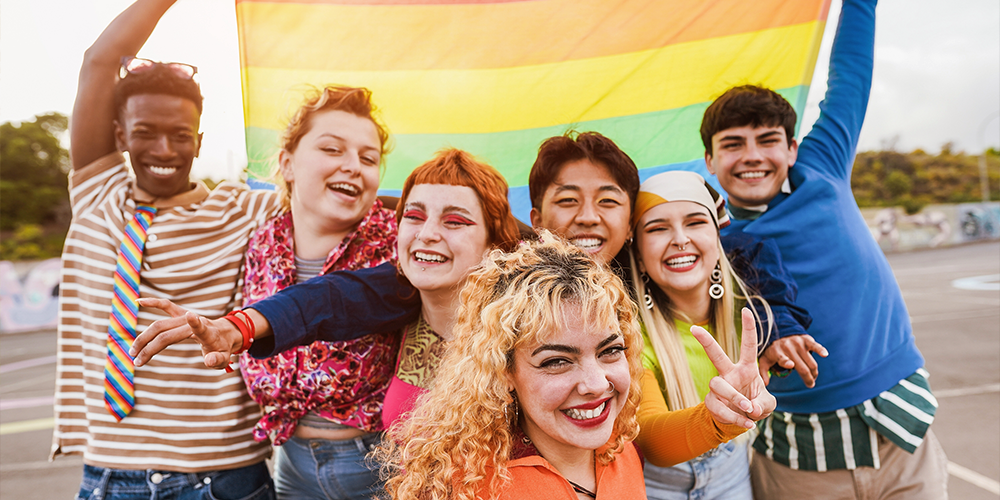Schools have an important role in creating positive and inclusive learning environments. However, for LGBTQ+ students, these environments can often feel unwelcoming and challenging to navigate. Here are some disturbing statistics:
- Suicide is the second leading cause of death among young people ages 10 to 14, and the third leading cause of death amongst 15-24 year-olds (Centers for Disease Control and Prevention, 2022). Lesbian, gay, bisexual, transgender, queer, and questioning (LGBTQ+) young people are at significantly increased risk.
- LGBTQ+ young people are more than four times as likely to attempt suicide than their peers. (Johns et al., 2019; Johns et al., 2020).
- The Trevor Project estimates that more than 1.8 million LGBTQ+ young people (ages 13-24) seriously consider suicide each year in the U.S. — and at least one attempts suicide every 45 seconds.
- The Trevor Project’s 2023 U.S. National Survey on the Mental Health of LGBTQ Young People found that 41% of LGBTQ+ young people seriously considered attempting suicide in the past year, including roughly half of transgender and nonbinary youth.
The lack of a supportive, connected, and nurturing school climate leads to increased experiences for LGBTQ+ students of bullying, isolation, and, tragically, a higher risk of suicide. Thankfully, there are proactive steps schools can take to create a safe space for LGBTQ+ students to thrive. Here are a few:
Combating Stigma Through Education
- Inclusive Curriculum: Make sure LGBTQ+ individuals can see themselves in the content you teach. Integrate diverse narratives, historical figures, and voices into existing coursework, showcasing the contributions of LGBTQ+ individuals across various fields. Representation matters!
- Professional Development: Ensure school staff learns information on LGBTQ+ identities, terminology, and the best ways to support students who identify as LGBTQ+. This Professional Development link from GLSEN (under “Educator Resources”) offers ideas for supporting school communities in the awareness and inclusion of LGBTQ students.
- Open Dialogue: Classroom discussions including respectful conversations about sexual orientation and gender identity can help “normalize.” The “Let’s Talk!” information from Learning for Justice provides tips about facilitating critical conversations with students.
Building Safe Spaces
- Gender-Neutral Facilities: Consider privacy, dignity, and respect for students’ gender identities with restrooms and locker rooms available to students who identify as LGBTQ+.
- Safe Zones: Empower faculty and staff to identify themselves as allies and provide support to LGBTQ+ students through visible signage and advocacy. Nancy Barile at Hey Teach! provides ideas in, “5 Things You Can Do to Support Your LGBTQ Students.”
- Student-Led Groups: Support the establishment of Gay-Straight Alliances (GSAs) or similar groups where students can connect and build community. This guide from GLSEN can help!
Promoting Acceptance and Respect
- Anti-Bullying Policies: Review your anti-bullying policies or student behavior expectations, and if needed, implement comprehensive anti-bullying policies that explicitly prohibit discrimination and maltreatment based on sexual orientation and gender identity, with clear consequences for students who are bullying and harassing others.
- Reporting: Ensure there are safe and accessible ways for students to report issues of bullying and harassment
- Celebrations: Include LGBTQ+ identities in school-wide events and activities These efforts are sure to foster a culture of empathy, understanding, and genuine connection. School staff are important role models for respectful behavior and for interrupting hate speech and threatening language in the moment.
Schools can lessen bullying, improve student mental health, and create a welcoming environment where LGBTQ+ students feel safe, supported, and empowered to be their authentic selves.
Additional Resources
- The Trevor Project: https://www.thetrevorproject.org/
- GLSEN: https://www.glsen.org/
- National Center for Transgender Equality: https://transequality.org/
If you’re ready to go a step further in making your school a safe place for LGBTQ+ students, be sure to check out Teaching Channnel’s graduate-level course 5143: Creating Safe and Supportive Spaces for LGBT+ Youth. In this course, educators will increase their understanding and awareness about strategies to support and champion students who identify as LGBTQ+. Explore the lived experiences of LGBTQ+ community and apply new understanding to ensure all students see themselves represented in the classroom, school, and community.
About the Author

Betsy Butler (she/her) is a Professional Learning Specialist at Teaching Channel. She holds a B.A. in English, and a Master’s in Education, and has been teaching since 1992. Betsy uses her three decades of teaching experience to write and revise our courses while selecting the perfect accompanying texts. Her specialty areas include ELA, special education topics, behavior management, and mental health.
Fun Fact: Betsy’s daily conquest is solving the New York Times crossword puzzle!







